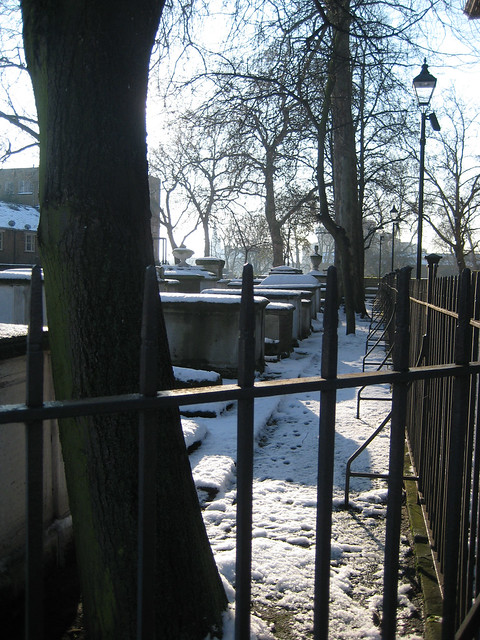There are many fascinating and important people buried at St John at Hackney Churchyard, who also help to tell the story of Hackney’s past and its place on the world map. A place of royal connections, landed gentry, world voyagers and rulers of the Empire, Hackney’s fresh air, grand houses and good schools as well as its easy access to the City, made it a very attractive and popular place to live. The fact that people have been coming to and travelling from Hackney all over the world for centuries is reflected in the people buried here and connected to this site.
Most tombs and stones are hard to read now. The thawing frost of 200 winters has split the sandstone ones, and rain has corroded the Portland Stone ones. Porous stone also attracts mosses which cover many of the memorials. The best surviving are those made of granite.
Legible memorials
Sir Thomas Player (d. 1685) and Dame Joyce Player (d. 1686)
Sir Thomas was an important city man, as Chamberlain of the city (finance director). We know they were extremely wealthy, not only from their coat of arms but also because they paid Hearth Tax on 14 hearths in their Hackney home. The earliest outdoor memorial – look for the ledger in the pavement on the west side of the tower, behind the old town hall.
Margaretta Beaufoy (d. 1800)
Born Quakers, of Huguenot descent, the Beaufoys were cousins who ran away to marry at Gretna Green in 1784. Mark Beaufoy was an astronomer and physicist who became the first Englishman to climb Mont Blanc in Switzerland. Margaretta died at the age of 36, leaving “Seven children to mourn her loss.” In the same vault are her father Benjamin (d.1805) and daughter Margaretta (d. 1840).
The Rowe Family (16th and 17th Century)
Sir Thomas and his son Sir Henry Rowe were both Lord Mayors of London, in 1592 and 1607 respectively. who had their own mausoleum and pews in St Augustine’s church. The family owned a great deal of land in Hackney, until all their money was lost and they sold it to the Tyssens from Holland, along with their pews. One member of the family, Owen Rowe, was a signatory to Charles I’s death warrant in 1649, and post-restoration was tried for regicide and imprisoned in the Tower of London.
Robert Batt (d. 1796)
“Of this parish a plumber”. Robert died aged 18, and is memorialised by his father. They were both in the booming building trade of the 18th Century and may have worked on some of Hackney’s grand Georgian houses.
Admiral Hunter (d. 1821)
Hunter was originally from Scotland and became one of the 18th century’s most travelled men, having joined Cook on early expeditions. He was the second governor of New South Wales in its early days as a colony, and is reputedly the first British man to have met an Aboriginal Australian. He has a valley named after him, from where fine Hunter Valley wine comes. He is buried with three nieces.
George Patterson (d. 1831)
Was the Accomptant (accountant) General of the East India Company, which ruled British India from 1759-1857. Many employees of the company also made a fortune with their own trades in the lucrative trades India could offer such as tea, indigo dye, opium and cotton. Several other East India Company employees are also buried at St John’s.
John James Watson (d. 1839) and his brother Joshua (d. 1855)
Established the Hackney Phalanx, an educational organisation aimed at providing schools for the poor. John Watson was the Rector of Hackney from 1799 – 1839. Many Watson children are also buried in the vault – many having died as young infants.
Conrad Loddiges (d. 1826)
Hackney’s pre-eminent horticulturalist in the 18th and 19th Centuries. He established a nursery along Mare Street, which boasted the biggest hot houses in Europe, collected plants and seeds form around the world and provided trees and plants for local gardens, royal parks and even botanical; gardens in Sydney. The family business closed in the 1850s. 13 members of the family, including several young children, are buried here.
Fred Peters (d. 193-)
Memorialised in a small plaque in the churchyard. Known as ‘Blind Fred’ he sold matches on the site for many years, and although not buried here, his memorial records him as a ‘sunny soul’ and includes a Braille inscription from the bible: ‘And this I know, where once I was blind, now I see.’
Francis Beaufort (d. 1857)
Of Huguenot descent via Ireland. Beaufort was an Admiral, famous for having invented the Beaufort Wind Scale, a system which enabled seafarers to voyage more safely, and is still used by weather forecasters and sailors today.
To find out more about the place and its people, visit Hackney Archives and Hackney Museum.
